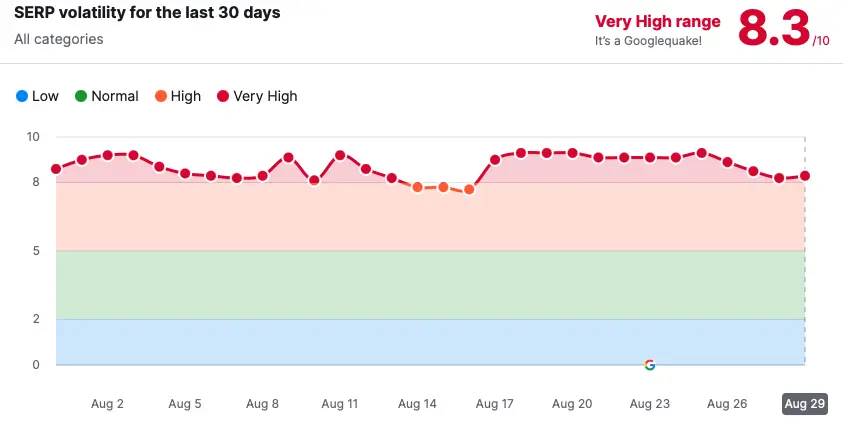Understanding SERP Volatility and How to Monitor It
Summary/TLDR;
- SERP Volatility: Indicates shifts in search rankings due to factors like algorithm updates.
- Monitoring’s Value: Crucial for adapting SEO and marketing strategies.
- Tools: Use platforms like Google Search Console, SEMrush, and Ahrefs.
- Proactivity: Actively monitor SERP changes to maintain website ranking.
The search engine results pages (SERPs) are constantly changing, a phenomenon known as SERP volatility.
Understanding the level of volatility in SERPs is important for digital marketing and SEO professionals. This volatility can have a significant impact on the visibility and organic traffic of websites, as they may experience sudden drops or surges in rankings.
In this article, we’ll explore SERP fluctuations and how beginners can monitor them effectively.
What is SERP Volatility?
SERP volatility refers to the frequency and extent of changes in search engine rankings.
A high SERP volatility means there’s a lot of change in rankings within a short time. Causes can range from a Google algorithm update, changes in search volume, or the advent of new SERP features like featured snippets.
- SERP features: Search results have changed over time. They now include extra details like featured snippets, local packs, and video results. These details can affect rankings.
- Algorithm change: Google regularly updates its search algorithm to improve SERP result quality.
- Website changes: Alterations in content, design, or structure can significantly influence rankings.
- Competitor activities: If a competitor enhances their site, it might affect your site’s standing.
- Seasonal factors: Keywords can see varying search volumes throughout the year, causing SERP shifts.

The volatility of SERP can vary depending on the industry and tracked keywords. Some keywords are more competitive or have frequent algorithm updates, so they may be more volatile.
Why Should You Monitor SERP Volatility?
If you want to boost your online presence, you need to know about SERP volatility. It’ll show you how positions change, which is the fluctuation in the search engine. And that’s why it’s key for online businesses.
Tracking SERP volatility allows you to gauge the health of your website’s rankings.
A high keyword rank today can plummet tomorrow, especially after Google updates. By monitoring these changes, you can make smart choices for your SEO tactics and maintain a steady page ranking.
- Problem Identification: A dip in your SERP standings might indicate an issue with your site’s content, design, or structure.
- Competitive Edge: By monitoring fluctuations, you can anticipate competitor moves and strategize accordingly.
- SEO Effectiveness: Observing the results of your SEO tweaks in real-time can guide future strategies. For instance, if a content revamp propels your ranking, it indicates that your strategy is on point.
How Can Beginners Monitor SERP Volatility?
For those new to SEO, SERP monitoring might seem daunting, but it should not be:
- Google Search Console: A free tool, it allows you to assess your site’s SERP performance and pinpoint potential issues.
- SEMrush or Ahrefs: These paid tools give in-depth SERP insights and can highlight performance trends.
- Visual Aids: For beginners, charts, and graphs can clarify the seemingly complex world of SERP volatility. Ahrefs and similar tools show graphs that track your website’s SERP ranking, making it easy to see patterns.
- Mobile vs. Desktop: Recognize that SERP volatility might differ between mobile and desktop searches. Given the increasing prevalence of mobile searches, optimization for both platforms is crucial.
Moreover, to see how your website’s title and meta description appear in search results, the SERP Preview Generator can be immensely helpful.
Businesses that rely on SEO traffic should monitor the amount of fluctuation of their particular keyword or set of keywords to identify any potential problems early on.
Top Free Websites to Check SERP Volatility Index
The SERP volatility index shows how much search engine rankings change over a period of time. With the right tools, you’ll be able to see how engine rankings for a particular site shift.
It’s especially true when checking rankings for a particular keyword. By tracking these keywords over a period, you can spot trends and adjust your strategy.
Tools like SEMrush Sensor and Mozcast offer insights into daily volatility scores. But, Google’s Search Console shows how your website ranks in Google’s top 20 search results.
- Wincher: A free tool for tracking the SERP Volatility Index.
- SEMrush Sensor: This dashboard provides extensive SERP volatility data.
- Mozcast: Tracks daily changes in Google SERPs.
- Algoroo: A tool that tracks Google algorithm changes.
The importance of understanding and monitoring SERP volatility cannot be overstated. Being proactive in this arena can make a big difference in your website’s ranking success.
Navigating High SERP Volatility
Experiencing high SERP volatility on your page? There could be several reasons:
- Technical issues: Ensure there are no crawl errors or indexing issues with your site.
- New content: Google has changed the way it views types of content. Maybe your new articles or product pages need some adjustments to fit the latest preferences.
- New competitors: Other sites might be vying for the same target keywords, causing a shuffle in the rankings.
- Backlinks: A loss of quality backlinks can decrease your site’s authority.
- User behavior: Your site’s SERP positioning can be affected by changes in search queries, search intent, and user behavior.
Best Practices in the Face of SERP Fluctuations
Effective monitoring involves:
- Audit your site regularly to ensure there are no technical errors.
- Optimize for both desktop and mobile devices.
- Consider the search intent behind a particular keyword and optimize accordingly.
- Analyze SERP feature changes to see whether a new SERP feature may affect your rankings.
- Monitor your organic search traffic to ensure it remains relatively stable.
- Adjust your strategy based on ranking algorithm updates.
Mobile vs. Desktop: A Crucial Distinction in SERP Volatility
In today’s digital age, there is an increasing shift towards mobile devices for web browsing. This change has led to distinct differences in how websites rank on mobile versus desktop search results. Each platform provides unique user experiences and search behaviors. Mobile searches often show local results and fewer organic results due to smaller screens.
Google, recognizing this shift, has implemented mobile-first indexing. Google mostly uses the mobile version of content for ranking and indexing.
Desktop users like longer content, but mobile users want quick answers or local solutions. Businesses need to adapt their content and SEO strategies to avoid volatile SERP rankings.
For beginners monitoring SERP volatility, understanding this distinction is paramount. Tools like Google Search Console offer device-based performance metrics. By monitoring these, you can see how well a website is doing on different devices and find areas to improve.
Wrapping Up
In the world of digital marketing, understanding SERP volatility is paramount. Changes in Google’s ranking algorithm, new content strategies, and competitors can all influence how a website ranks.
To keep your website competitive, track specific SERP changes, understand nuances, and based on daily volatility.
Navigating the intricacies of SERP volatility might seem daunting, especially for beginners. However, by having the right knowledge, tools, and being proactive, businesses can stay ahead. This helps their digital presence remain strong on all platforms.
References:
